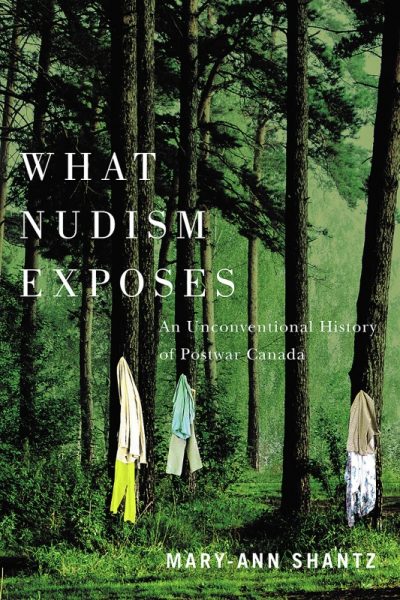
What Nudism Exposes: An Unconventional History of Postwar Canada
Review By Bob Hummelt
May 16, 2023
BC Studies no. 217 Spring 2023 | p. 122-124
In the late 1960s, Canadian philosopher George Grant expressed concern over the expense and energy poured into non-evaluative sciences — the humanities — where researching scholars “could cover themselves with the mantle of science and Protestant busyness.” (Grant 111) Current day social, and more recently, food history, would fall into Grant’s critical gaze. Grant did concede that work in these “small areas” made up the “mosaic” where the past can inform the future. Using Grant’s sluice, Bettina Liverant’s Buying Happiness: the Emergence of Consumer Consciousness in English Canada might have value, although Janis Thiessen’s compelling Snacks: A Canadian Food History might stir his indigestion. Amid a vast Canadian social history landscape lies Shantz’s self-identified unconventional history of social nudism in Canada. While this seemingly obscure topic might have raised Grant’s eyebrows, Shantz’s richly researched and insightful book nestles comfortably, if not conventionally, with other social histories that acknowledge the impact of traditional values and persistent patriarchal influences on early post-war society.
Social nudism in Canada is met with skepticism, if not with uncomfortable mirth, as evident by CBC Radio’s This is That comedy sketch detailing Canada Post issuing commemorative stamps of Wreck Beach. However, while not a mainstream activity, a post-war nudist movement promoted the benefits of recreating without clothes, initially within the confines of nudist clubs, and in time, along spans of public spaces such as Vancouver’s Wreck Beach. Shantz examines this movement in the immediate post-war years to the 1970s to determine “the body’s position at the intersection of nature and culture, the individual and the social, the private and the public.” (4)
Shantz rightly asserts that clubs clearly were not libertarian environs. Admission requirements tilted to favour white, straight, and middle class families. Respectability in the eyes of a curious public was paramount, messaging that mixed-sex nudity was wholesome, yet sexuality was problematic; any expression of it while on club grounds was suppressed with strict rules. In an era where business and service-work orientated Rotarians were supported by their “better halves”, the Rotary Anns, similar gender divisions ensured the preservation of family and femininity behind club fences. Men performed most of the construction and upkeep duties, leaving women to occupy themselves with domestic matters, unfettered by worries over what to wear, yet still taking care to wear makeup. As Shantz notes, “while sex might have no place in a nudist club, gender did.” (92)
Shantz effectively develops other contradictions within the movement. Clubs sought publicity to deliver their message and to cultivate sustainable membership to fund facilities using two key vehicles, the publication of journals such as Sunbathing for Health and the staging of nude beauty pageants. However, both belied the underlying philosophies the clubs espoused, and perhaps unwittingly used women as marketing tools. Photos of attractive, mostly female models, were mainstay and popular features of the journal. Pageants became well attended and publicized events to crown “Miss Nude,” where celebrity judges used body measurements to score contestants.
Shantz also sharply contrasts the nature of clubs and nude spaces, with the former bent on taming the environment to develop comfortable, controlled and appealing facilities, whereas Wreck Beach, after significant controversy, was recognized as a natural clothing optional setting free from rules. Here, Shantz points out that this freedom could mean different things to users. Today, most Canadians’ experiences with social nudity will likely come at a nude beach, where an edgy or a rejuvenating experience might be determined by the comportment of fellow bathers. A few will vote with their bare feet; however, this book suggests that mindsets and spaces for the naked human body will continue to be negotiated.
References
Grant, George. 1969. House of Anansi Press. “The University Curriculum”. In Technology and Empire.
https://www.cbc.ca/radio/thisisthat/this-is-that-s-best-of-2016-1.3901143/canada-post-to-release-nude-stamp-honouring-wreck-beach-1.3901171
Publication Information
Shantz, Mary-Ann. What Nudism Exposes: An Unconventional History of Postwar Canada. UBC Press: Vancouver, 2023. 268 pp. $34.95 paper.
